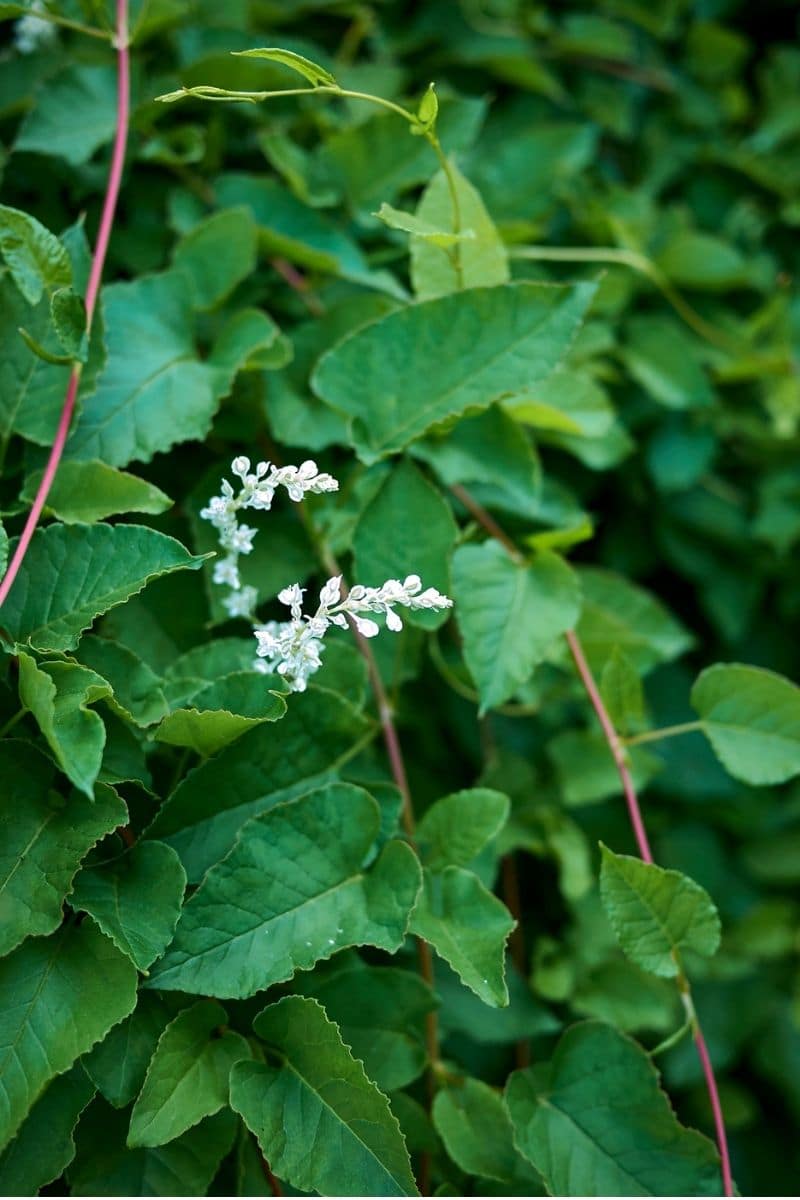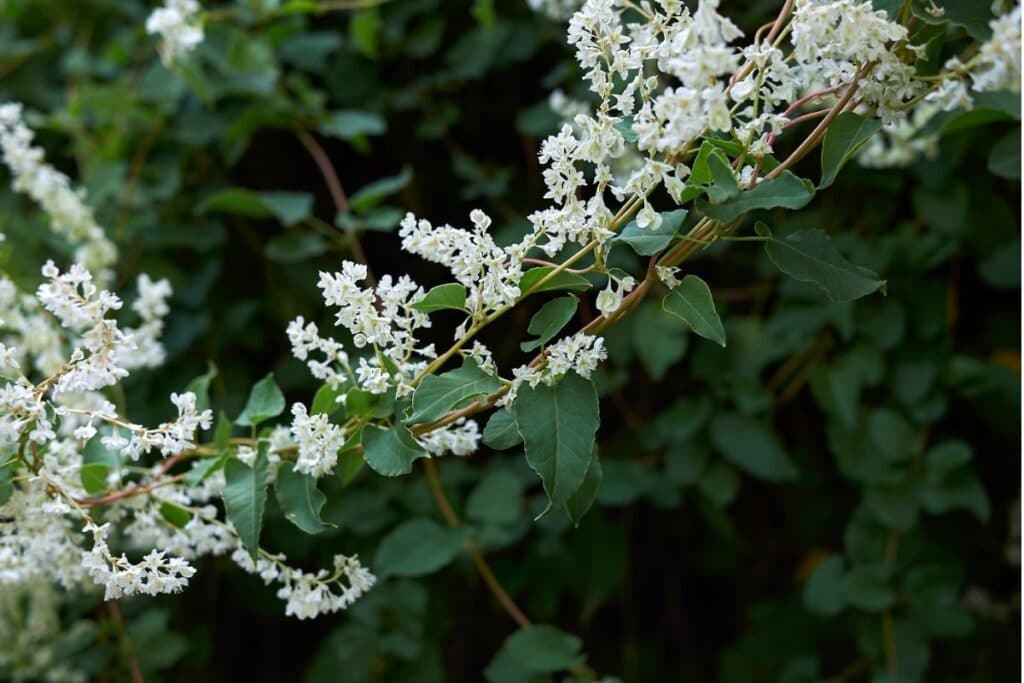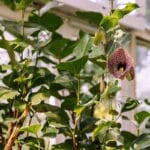In life, we often try to look at the silver lining in every situation. Silver linings can now be incorporated and visualized in the landscape with the use of Silver Lace Vines. The trails of clumped white flowers and green leaves will improve any landscape.
However, risks of the potential harm this plant may cause should be considered carefully. Written below is the core information you need to know before choosing this vine.
Botanical Information
The commonly known Silver Lace Vine also goes by the names Russian Vine, Fleece Flower, Fleece Vine, Chinese Bindweed, Mile-a-minute vine, Chinese Fleece Vine, China Fleece Vine, Fleece Flower Vine, Bukhara fleeceflower, and Silver Fleece Vine.
Despite having multiple common names, it is known as Fallopia aubertii, synonymous with Polygonum aubertii, in the scientific community. Coming from the family Polygonaceae, often referred to as the knotweed family, this rapidly growing vine will give a sense of regality because of its appearance.
Spatial distribution
The Silver Lace Vine is a native of China but it can thrive in USDA zones 5 to 8.

Leaves
The vine has lengthy and twisted stems that are green with a hint of red. The older parts of the stems become hard and woody, which is usually seen on the basal part of the plant. Growing up to 25 to 35 feet tall, the stem is surrounded by leaves that resemble an arrowhead. The leaves are attached to the stem with 1.5 to 4 inches of petioles. This oval-shaped leaf with a pointed apex has a smooth margin, simple, and alternate leaf patterns.
Flowers
Being true to its name, the Silver Lace Vine blooms beautifully with branched panicles with a cluster of small white flowers. It can be slim, fanned out, or dangling in nature with clusters that elongated for 6 to 8 inches long.
Each flower is less than half an inch and is suspended by its short pedicels. Premature flowers are usually reddish, but as it matures, it changes its color to light green, white, or pale pink with five petals for each flower. There are instances when the flower turns pink during maturity before the fruit sets.
One can observe the fragrant and glamorous blooms during mid-summer to early fall. Its scent and pigment are beneficial in attracting pollinators, such as honeybees.
Fruit and Seeds
As the flowers turn pink, the fruits start to develop. The fruits are also pink and slightly triangular or pointed. In the seed formation, hard black satiny seeds with three ridges are produced. Its seeds are a product of dry fruit, wherein cracking open is not an option during maturity.
Growth and Development
The Silver Lace plant loves to grow and show off during mid-summer, late summer, and early fall. During these times, it showcases its climbing and twining prowess and spreads throughout the landscape, from the existing vegetation to man-made structures such as fences and pergolas.
In a year, the vine can grow up to 15 feet due to its vigorous growth habit. Since it belongs to the knotweed family, the Silver Lace vine can easily reproduce by seeds, stem cutting, and leaf stalks, similar to its relative knotweed species.
The showing of flowers begins around late summer and early fall. It produces clusters of white fragrant flowers that turn red as it starts fruit setting. The blooms usually last for two months which adds a color of purity in the landscape longer, but along with this is the dropping of abscised flowers. This may be a problem in terms of landscape maintenance, so it’s best to avoid planting it near patios.

Grow, Care and Maintenance Tips
Making this vine flourish is not much of a challenge but maintaining and controlling this vine might need some extra effort. Below are the best cultural practices and growing environment for the Russian Vine.
Sun Requirement
The vine can survive in places where there is a partial shade or full sun. At least 4 hours of continuous exposure to the sun should be given to optimizing growth. During flower formation, at least 6 hours of sunlight is highly recommended.
Water Requirement
The vine thrives in areas with dry to moist conditions. Given this premise, it is recommended to schedule the watering of this plant at least every 2 days under normal weather conditions. If it is too hot or cold outside, adjust the watering schedule accordingly. Grouping or planting it together with other plants that do not require much watering is advised.
Temperature and Humidity Requirement
In general, the Russian Vine grows in normal temperatures to slightly hotter or colder conditions. It can tolerate urban pollution, which makes it a good urban plant.
Fertilizer
The application of fertilizer is not necessary if the soil is rich in organic matter. However, during its growing season, it is advisable to avoid applying a fertilizer that is rich in Nitrogen, as it may hinder flower production and promote the creation of new leaves.
Soil Requirement
This woody vine dislikes being in soils that hold too much moisture. Planting the Silver Lace Vine in well-drained and slightly dry soil with a pH ranging from 5.5 to 7 will optimize its development. Some of the soil types it can be planted in are sand, sandy-loam, and loam soils. Avoid clayey soils or those that are too clump and wet.
Propagation
As this perennial woody vine vastly grows, propagation is relatively easy. It can be propagated through the planting of seeds and stem cuttings.
In choosing planting materials for stem cuttings, choose the ones that are as thick as a regular pencil with 4 to 6 leaves remaining. Planting in pots with moist well-drained soils plus application of root hormone is recommended. Transplanting may be done depending on the plant’s sturdiness.
Trimming
The Silver Lace Vine’s fast growth and woody mature stems may be a harmful characteristic combination in some instances. As a robust climber, it can grow eight meters high annually with its foliage forming a dense screen with some dangling or resembling a flower shower.
Same with wisterias, it will be a problem if the stem wraps around important cable lines and pipes as it will harden as it matures. To avoid such issues, regular trimming and severe pruning should be done to train and tame the vine. Extensive pruning during early spring will be favorable for the plant’s development.
Uses
It is without a doubt that this vine can grow faster than other existing vegetation in the landscape. During the planning part of the landscape, it is necessary to consider the growth habits of any plant.
In this case, the Silver Lace Vine should be placed in low-risk areas meaning far from buildings, downpipes, lightning conductors, and eave gutters. It is recommended to maintain at least 1.5 meters away from the said fixtures and other existing plants.
If the goal is to let it crawl and twine in a structure such as trellises and arbors, make sure that the materials to be used are heavy-duty that can support the vine in the long run.
Common Problems Caused by Silver Lace Vines
One of the most common problems is overgrowth, competition, and health hazards. In terms of overgrowth, it can disrupt cables and pipes that may be a fire hazard especially when the plant matures and the stem becomes woody.
Then, the presence of a fast-growing vine is a threat to plants that do not grow as aggressively. The Russian vine might colonize and destroy other plants around it as it crawls and reproduces.
Lastly, as a common characteristic of plants belonging to the Polygonaceae family, oxalate is incorporated into the plant. If large amounts are ingested by dogs and other animals, kidney problems may occur.
FAQs
How much sun does silver lace vine need?
Silver lace vine, also known as Polygonum aubertii or Fallopia baldschuanica, prefers full sun to partial shade. It can tolerate a wide range of light conditions but tends to bloom more profusely with plenty of sunlight.
Why is my silver lace vine dying?
Several factors could cause a silver lace vine to appear to be dying, including overwatering, underwatering, poor soil drainage, nutrient deficiencies, pests, diseases, or environmental stressors. Assess the plant’s growing conditions and address any underlying issues to revive its health.
Can you grow silver lace vine in a container?
Yes, you can grow silver lace vine in a container. Choose a large container with adequate drainage holes, and use a well drained soil potting mix. Provide support for the vine to climb, such as a trellis or arbor, and ensure it receives sufficient sunlight and water. Regular pruning may also be necessary to manage its growth in a container.
*image by simonapavan/depositphotos






